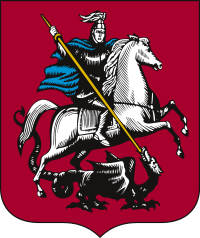
Back Гісторыя Масквы Byelorussian Гісторыя Масквы BE-X-OLD Moskvas historie Danish Historio de Moskvo Esperanto Historia de Moscú Spanish Histoire de Moscou French Historia de Moscova Galician Moszkva története Hungarian モスクワの歴史 Japanese მოსკოვის ისტორია Georgian
This article needs additional citations for verification. (March 2022) |

The city of Moscow gradually grew around the Moscow Kremlin, beginning in the 14th century. It was the capital of the Grand Duchy of Moscow (or Muscovy) and then the Tsardom of Russia until the capital was moved to Saint Petersburg by Peter the Great. Moscow was the capital of the Russian Soviet Federative Socialist Republic from 1918, which then became the Soviet Union (1922 to 1991), and since 1991 has served as capital of the Russian Federation.[1]
Situated on either bank of the eponymous Moskva River, the city during the 16th to 17th centuries grew up in five concentric divisions, formerly separated from one another by walls: the Kremlin ("fortress"), Kitaigorod ("walled town", but interpreted as "Chinatown" by folk etymology), Bielygorod ("white town"), Zemlianoigorod ("earthworks town"), and Miestchanskygorod ("bourgeois town") outside the city walls.
After the fire of 1812, the city ramparts were replaced with the Boulevard Ring and Garden Ring roads, replacing the walls around Bielygorod and Zemlianoigorod, respectively. The city's population grew from 250,000 to over a million in the 19th century, and from one to ten million in the 20th century, putting it among the top twenty of the world's most populous cities today.
- ^ Robert Argenbright, "Moscow On The Rise: From Primate City To Megaregion," Geographical Review (2013) 103#1 pp 20–36.
© MMXXIII Rich X Search. We shall prevail. All rights reserved. Rich X Search